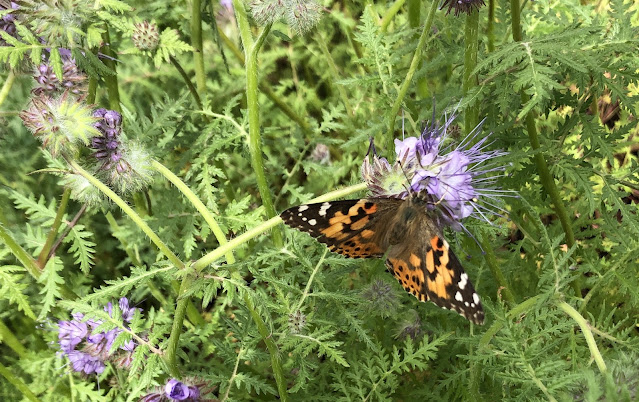
Get inspired to go native in your garden

|
|
This painted lady butterfly has a thing for lacy phacelia, an annual herb and California native plant. (Photo: Kathy Morrison)
|
Such a busy time for gardens and gardeners! But we don't want the week to end before acknowledging California Native Plant Week, which runs through Saturday.
The California Native Plant Society, not surprisingly, leads the charge on this celebration. CNPS has posted seven inspiring videos on Californians who are "enriching lives and landscapes with native plants." One of the videos focuses on Sacramento's own Miridae Landscape Design and founder Billy Krimmel's home garden. Check out all the videos here .
CNPS also is the driving force behind the Bloom! California partnership with local nurseries around the state. In Sacramento, The Plant Foundry at 35th and Broadway is participating in the program; the informative booklet produced by Bloom! California is available there.
The booklet is a great guide to easy-to-grow California natives that do well in all areas of the state, including clarkia, currants, phacelia, sage, toyon and yarrow. These natives and others also provide crucial habitat for birds, bees, butterflies and other pollinators and wildlife.
Celebrate the plants that are at home in our backyards and our wildlands -- and try planting some new ones this month.
-- Kathy Morrison
P.S. In addition to The Plant Foundry, great sources locally for native plants are the various master gardener plant sales and the UC Davis Arboretum Teaching Nursery plant sales. April 30 is the date for both the El Dorado County master gardener sale of ornamentals and the final Arboretum Nursery sale of the spring.
Comments
0 comments have been posted.Sacramento Digs Gardening to your inbox.
Sites We Like
Garden Checklist for week of April 14
It's still not warm enough to transplant tomatoes directly in the ground, but we’re getting there.
* April is the last chance to plant citrus trees such as dwarf orange, lemon and kumquat. These trees also look good in landscaping and provide fresh fruit in winter.
* Smell orange blossoms? Feed citrus trees with a low dose of balanced fertilizer (such as 10-10-10) during bloom to help set fruit. Keep an eye out for ants.
* Apply slow-release fertilizer to the lawn.
* Thoroughly clean debris from the bottom of outdoor ponds or fountains.
* Spring brings a flush of rapid growth, and that means your garden needs nutrients. Fertilize shrubs and trees with a slow-release fertilizer. Or mulch with a 1-inch layer of compost.
* Azaleas and camellias looking a little yellow? If leaves are turning yellow between the veins, give them a boost with chelated iron.
* Trim dead flowers but not leaves from spring-flowering bulbs such as daffodils and tulips. Those leaves gather energy to create next year's flowers. Also, give the bulbs a fertilizer boost after bloom.
* Pinch chrysanthemums back to 12 inches for fall flowers. Cut old stems to the ground.
* Mulch around plants to conserve moisture and control weeds.
* From seed, plant beans, beets, cantaloupes, carrots, corn, cucumbers, melons, radishes and squash.
* Plant onion sets.
* In the flower garden, plant seeds for asters, cosmos, celosia, marigolds, salvia, sunflowers and zinnias.
* Transplant petunias, zinnias, geraniums and other summer bloomers.
* Plant perennials and dahlia tubers for summer bloom.
* Mid to late April is about the last chance to plant summer bulbs, such as gladiolus and tuberous begonias.
* Transplant lettuce seedlings. Choose varieties that mature quickly such as loose leaf.